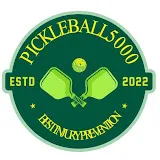0:00
Hey guys, Tony Maritato here, licensed physical therapist, and behind me on the screen is one
0:05
of my favorite YouTube channels related to pickleball. It's primetime pickleball. They're talking about mistakes made with a backhand return or volley, and I want to talk
0:15
about the muscle action that's required for this basic motion and how it relates to rotator
0:22
cuff injury, rotator cuff pain, or rotator cuff tears. so I'm going to play this in a slow motion speed so that we can kind of watch what's going on so
0:32
right here she's got the wind up she's got the contact and she's got the follow through and it's
0:38
a beautiful stroke and you can see here when she goes into her backhand she winds up and right as
0:47
she makes contact, that motion is essentially internally rotating the arm and horizontal
0:55
adduction of the shoulder. Those two motions are usually pretty comfortable even when somebody has
1:01
a rotator cuff tear or injury. But what happens is as she starts to accelerate through toward the
1:08
ball and at contact with the ball, that's probably one of the most challenging positions for somebody
1:14
who has an inflamed rotator cuff tendon, whether it be the supraspinatus or any of the four
1:21
rotator cuff muscle tendons, because that is taking you from a horizontal AD ducted position
1:28
to an AB ducted position. It's taking you from internal rotation to external rotation
1:34
and that is typically the hardest position for the shoulder to move when it's actively
1:39
inflamed and painful and then of course after she makes contact with the ball
1:44
finishing in this nice high externally rotated abducted shoulder position again that a really challenging position whether you have limited or full range of motion just knowing that that probably going
1:58
to be one of the hardest things for you to deal with if you continue to play pickleball with an
2:04
inflamed shoulder so what we want to understand is we want to say well is there a way for me to
2:09
still utilize a backhand strategy to return a ball without necessarily compromising the integrity of
2:17
the rotator cuff muscles themselves so this is all great i would use exactly your same technique
2:23
for your wind up and then once you're making that contact while it's ideal to finish in that
2:32
high abducted position to conserve kind of what's going on in the shoulder what I would recommend is
2:39
you swing through you make beautiful contact and then you finish in a low palm forward position
2:46
you're still going to get the external rotation but now your hand is going to be down by your thigh
2:51
rather than up over the shoulder that's going to allow you to continue to play while you're
2:57
figuring out what you're going to do with the shoulder and it's going to reduce the active
3:01
exacerbation and the damage associated with whatever is going on so that you can manage
3:07
the symptoms. You know, part of keeping the sport that you love in your life is understanding how to
3:14
modify the things that you're doing so you can continue to play without causing more
3:18
tissue damage and trauma before you get full recovery. So guys, if you have more questions, I'm going to go through a couple of the other movements
3:27
Like we'll go through a forehand. We'll go through a serve. but I just wanted to start with the backhand because I know this is one of the most complicated
3:34
movements for anybody who's dealing with shoulder pain. I will catch you guys on the next video
3:39
Thanks so much for watching


